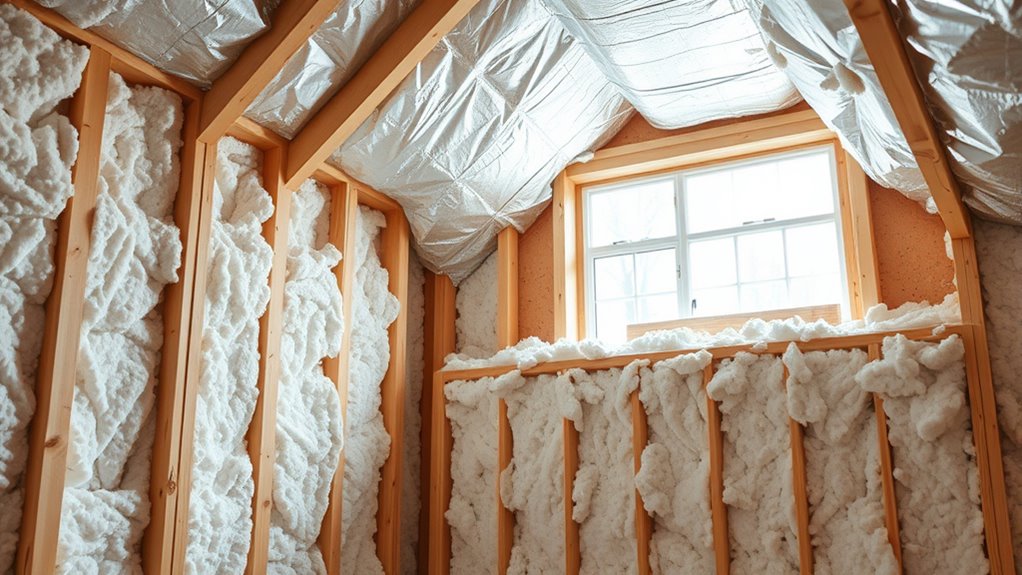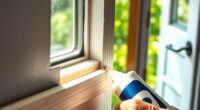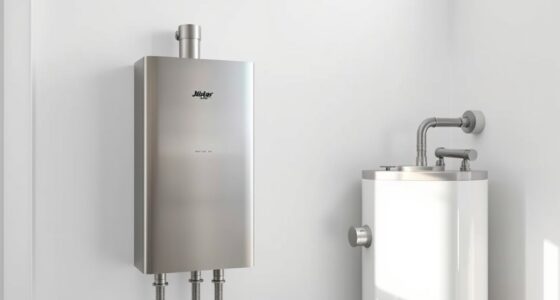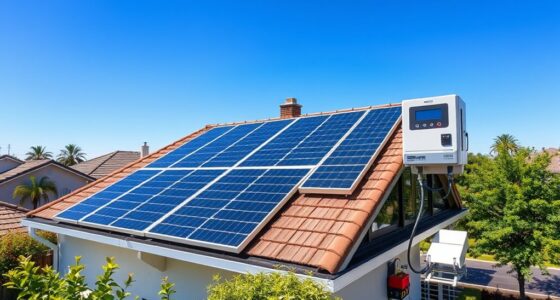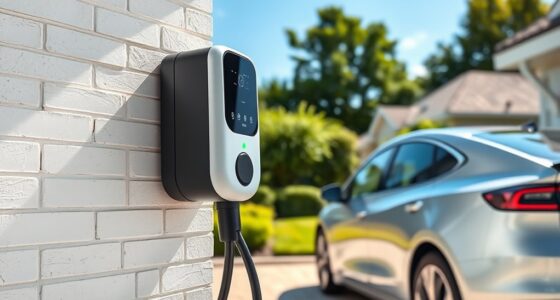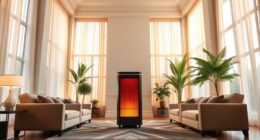To improve your home insulation and save energy, start by inspecting existing insulation for gaps or insufficient coverage and seal air leaks around windows, doors, and openings. Upgrade with appropriate materials like blown-in cellulose, spray foam, or foam boards based on your climate and budget. Consider installing radiant barriers and ensuring proper ventilation in basements and crawlspaces. Implementing these strategies will boost efficiency and comfort; explore further tips to make your home even more energy-smart.
Key Takeaways
- Conduct an energy audit to identify and seal air leaks around windows, doors, and openings for better insulation efficiency.
- Upgrade attic and wall insulation to meet regional R-value recommendations, using DIY or professional installation.
- Add weatherstripping and caulking to seal gaps, improving air tightness and reducing heat loss.
- Install reflective radiant barriers in hot climates and spray foam or foam board in basements and crawlspaces for enhanced insulation.
- Regularly maintain insulation and sealing measures to ensure long-term energy savings and home comfort.
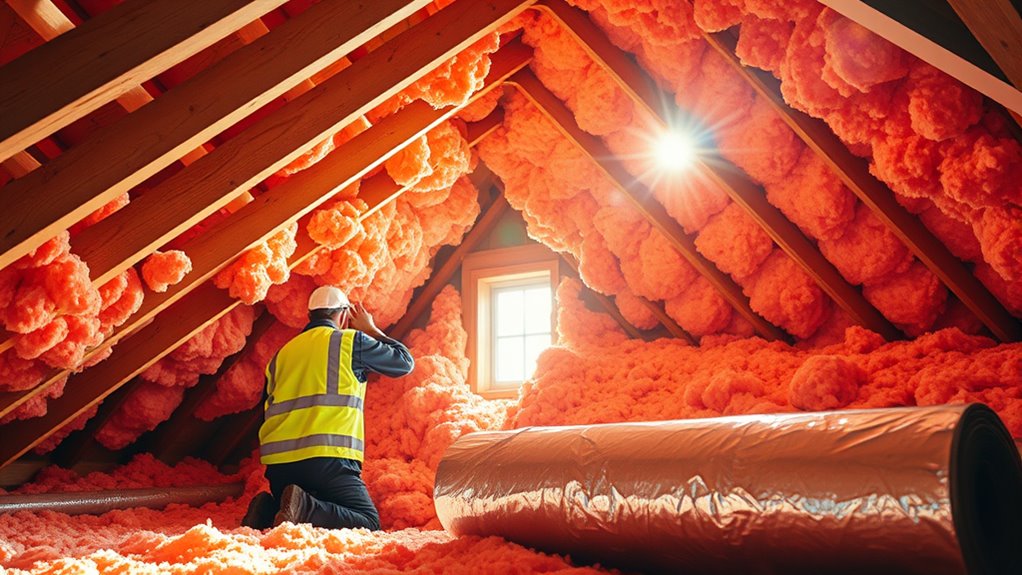
Improving your home’s insulation is an effective way to reduce energy bills and increase comfort year-round. To start, assess what insulation you already have in place. Check the thickness and type of existing insulation in your attic, walls, and basement. This will help you identify gaps and areas needing improvement. Conduct an energy audit to pinpoint where heat escapes or enters unnecessarily. Many utility companies offer these assessments, which highlight leaks and inefficiencies. During the inspection, look for air leaks around windows, doors, and other openings. Sealing these gaps is essential because even the best insulation can’t compensate for drafts. Use caulking around non-moving joints and weatherstripping on doors and windows to block air leaks effectively. For larger gaps, expanding foam or spray foam can provide a stronger seal.
Start by assessing existing insulation and sealing air leaks for better energy efficiency.
Once you understand your home’s needs, set clear R-value goals for each area. The R-value measures insulation’s resistance to heat flow; higher values mean better insulation. Your climate determines the ideal R-value, so research recommendations for your region. Creating a realistic budget is fundamental—consider costs for materials and professional installation if needed. Some insulation types are DIY-friendly, like fiberglass batts or blown-in cellulose, which work well in attics and walls. Spray foam offers superior sealing and insulation but often requires professional installation. For attic spaces, loose-fill or blown-in insulation is a quick, effective solution, especially in hard-to-reach corners, while radiant barriers can reflect heat away during hot months. Wall insulation can be added with non-invasive methods like injection foam or blown-in cellulose, minimizing disruption. For existing homes, spray foam in wall cavities provides an excellent air barrier and insulation boost.
Basements and crawlspaces often need special attention. Closed-cell spray foam works well here due to its water resistance, helping prevent moisture issues. Insulating basement walls with foam board or fiberglass batts can improve overall energy efficiency. Remember, crawlspace ventilation remains essential to prevent moisture buildup, which can undermine insulation effectiveness. Additionally, insulation’s effectiveness depends on proper installation and maintenance. When it comes to installation, consider whether a DIY approach fits your skill level or if professional help is necessary. For complex projects or high-performance goals, hiring experts ensures proper installation, maximizing insulation benefits. For simpler tasks, weatherproofing kits and basic sealing techniques can make a noticeable difference.
In all cases, diligent air sealing complements your insulation efforts. Sealing gaps around windows, doors, and other penetrations keeps warm or cool air inside, reducing the workload on your HVAC system. Combining effective insulation with proper air sealing creates a comprehensive barrier, dramatically improving your home’s energy efficiency. This not only lowers your utility bills but also enhances comfort throughout the year.
Frequently Asked Questions
What Are the Best Insulation Materials for Different Climates?
You’re curious about the best insulation materials for different climates. For mixed climates, you should consider cellulose or mineral wool, which provide good thermal performance and fire resistance. In humid or coastal areas, opt for closed-cell spray foam or sheep’s wool to prevent moisture issues. For extreme temperatures, materials like aerogel or vacuum panels deliver superior insulation. Choose wisely based on your climate to maximize energy savings and comfort.
How Often Should Home Insulation Be Inspected or Replaced?
You should inspect your home insulation annually to catch early signs of damage or degradation, especially if you notice high energy bills, physical damage, or if your home is over 15 years old. If annual inspections aren’t possible, every five years is the minimum. Replace insulation every 15 years or sooner if it shows signs of wear, damage, or reduced efficiency, to keep your home comfortable and energy-efficient.
Can DIY Insulation Upgrades Be as Effective as Professional Work?
Imagine your home as a cozy fortress, where insulation is the shield against the cold. DIY upgrades can be effective, but they often lack the precision of a professional’s touch. Without expert knowledge and proper tools, you risk gaps and leaks that let energy escape like a sieve. While DIY can help, a professional’s skill guarantees your fortress stays warm and energy-efficient, sealing every crack with military-grade precision.
What Are the Signs of Inadequate Home Insulation?
You notice signs of inadequate insulation when your energy bills rise unexpectedly, especially during seasonal changes. Feel cold drafts or uneven temperatures between rooms, even with your HVAC running normally. You might see condensation, mold, or ice dams forming, indicating thermal leaks. Cold floors, walls, or persistent humidity issues also point to insulation problems. These signs suggest your home isn’t retaining heat well, prompting you to contemplate upgrading your insulation.
How Does Insulation Impact Indoor Air Quality and Health?
You should know that proper insulation stabilizes your home’s temperature and reduces moisture buildup, preventing mold and mildew that harm air quality. It also limits outdoor pollutants from entering, especially when combined with good air sealing. High-quality insulation minimizes harmful emissions, while poor materials can release VOCs. Remember, balancing insulation with adequate ventilation keeps indoor air fresh, reducing health issues like allergies and respiratory problems caused by pollutants and microbes.
Conclusion
Think of your home as a cozy sweater; the better the insulation, the warmer and more efficient it stays. By sealing gaps, upgrading insulation, and maintaining your system, you’re wrapping your house in a protective layer that keeps energy in and drafts out. With these simple steps, you’ll turn your home into a fortress of comfort, saving money and energy. Remember, a well-insulated house is like a warm hug that lasts all year long.

